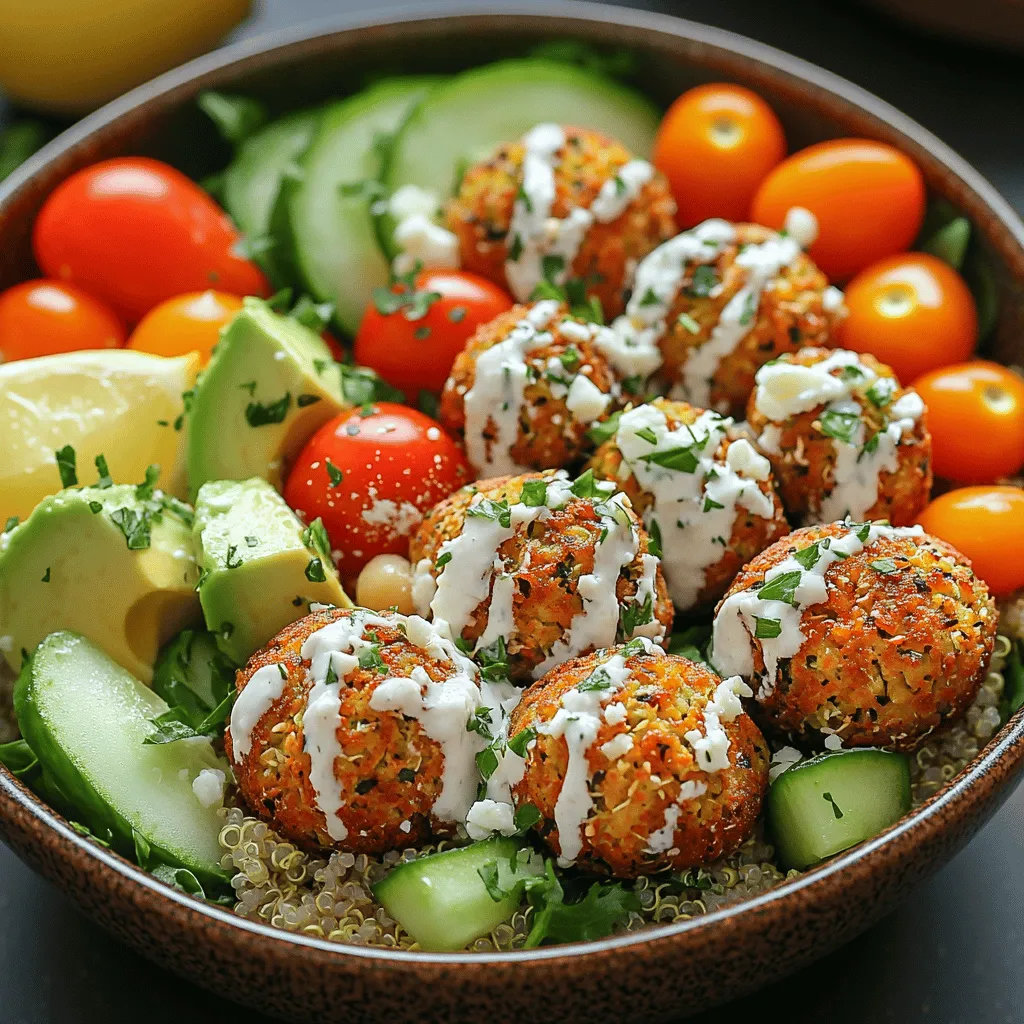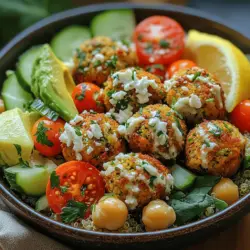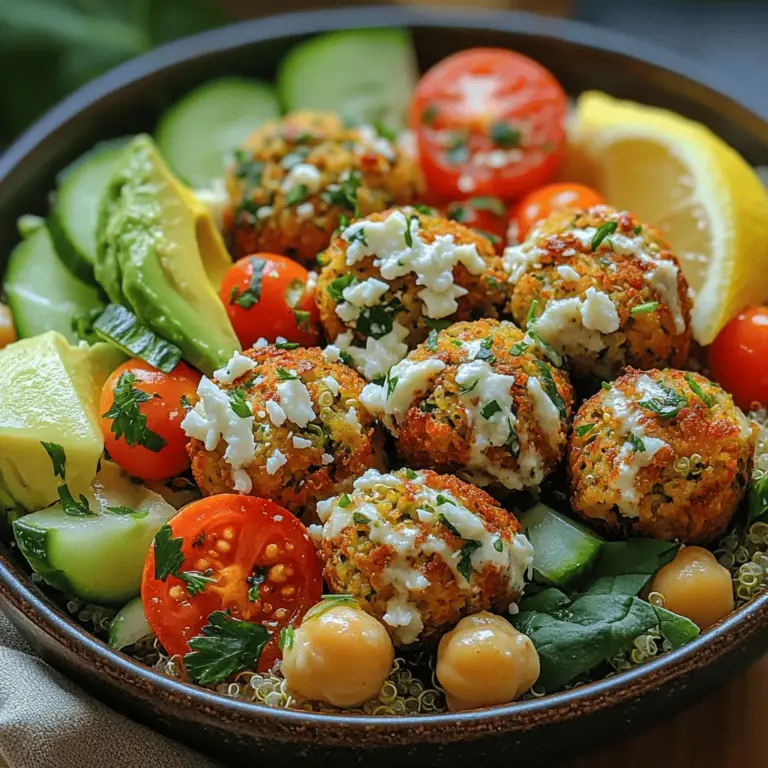Baked Falafel Power Bowls: A Wholesome Introduction
In recent years, plant-based meals have surged in popularity, resonating with health-conscious eaters and environmentally aware consumers alike. Among the myriad of dishes that celebrate the essence of plant-based eating, the Baked Falafel Power Bowl stands out for its delightful balance of flavor, nutrition, and versatility. This dish, which features protein-packed chickpeas as its star ingredient, is enriched with vibrant vegetables and complemented by a creamy tahini dressing, making it not only a delicious meal but also a wholesome choice for anyone looking to elevate their dining experience.
The rise of plant-based diets can be attributed to a growing awareness of the benefits of incorporating more vegetables, legumes, and whole grains into our diets. With an increasing number of people adopting vegetarian or vegan lifestyles, recipes like the Baked Falafel Power Bowl provide a satisfying and nutrient-dense option that appeals to both dietary preferences and taste buds. This article will delve into the details of creating this power-packed meal, covering everything from its health benefits to step-by-step instructions and creative variations.
Understanding the Ingredients
The foundation of any great recipe lies in its ingredients. In the case of the Baked Falafel Power Bowl, each component plays a crucial role not only in flavor but also in contributing to the overall nutritional profile of the dish. Below, we explore the primary ingredients that come together to create this vibrant meal.
The Chickpeas: A Protein Powerhouse
At the core of our Baked Falafel lies the humble chickpea, also known as garbanzo beans. These small legumes are a remarkable source of plant-based protein and dietary fiber, making them an excellent choice for those looking to increase their protein intake without relying on animal products. A single serving of chickpeas contains approximately 15 grams of protein, which is comparable to meat-based sources.
In addition to their protein content, chickpeas are rich in essential vitamins and minerals, including iron, magnesium, and folate. Incorporating chickpeas into your diet can promote digestive health due to their high fiber content, which aids in maintaining regular bowel movements and supporting gut health. Furthermore, chickpeas have been linked to improved heart health and weight management, making them a valuable addition to any balanced diet.
Fresh Herbs and Aromatics: Flavor and Nutrition
No falafel is complete without the addition of fresh herbs and aromatics, which elevate the dish’s flavor profile. Parsley and cilantro are two key herbs commonly used in falafel recipes. Not only do they add a burst of freshness, but they are also packed with vitamins A, C, and K, as well as antioxidants that can promote overall health.
Onions and garlic, often included in the falafel mixture, serve to enhance the flavor and provide their own set of health benefits. Onions are known for their anti-inflammatory properties and may help reduce the risk of chronic diseases, while garlic has been associated with numerous health benefits, including improved immune function and cardiovascular health. Together, these ingredients create a fragrant and flavorful base for our falafel.
Spices: The Heart of Falafel
Spices are what truly bring falafel to life, and the combination of ground cumin and coriander is essential for achieving that authentic Middle Eastern flavor. Cumin is not only aromatic but also boasts a variety of health benefits, including anti-inflammatory properties and improved digestion. Coriander, on the other hand, has been shown to have antioxidant effects and may help lower blood sugar levels.
The careful balance of these spices not only contributes to the distinctive taste of falafel but also enhances the overall health benefits of the dish, making it a flavorful yet nutritious option for any meal.
Healthy Fats: The Role of Olive Oil and Avocado
In preparing our Baked Falafel Power Bowl, healthy fats play an important role in both flavor and nutrition. Olive oil is often used in the preparation of falafel to help achieve a crispy texture during baking. Rich in monounsaturated fats, olive oil has been linked to numerous health benefits, including reduced inflammation and a lower risk of heart disease. It also contains antioxidants that can support overall health.
Avocado is another key ingredient that provides healthy fats and adds creaminess to the dish. Packed with vitamins, minerals, and fiber, avocados are an excellent source of potassium and can help support heart health. Including avocado in your power bowl not only enhances its nutritional value but also contributes a rich, buttery texture that complements the baked falafel perfectly.
The Base: Quinoa vs. Brown Rice
To create a satisfying power bowl, one must choose the right base to complement the falafel. Both quinoa and brown rice are popular options, each with its own unique nutritional profile. Quinoa is a complete protein, meaning it contains all nine essential amino acids, making it an excellent choice for those following a plant-based diet. It is also gluten-free and high in fiber, which can aid in digestion and promote a feeling of fullness.
Brown rice, while not a complete protein, is a whole grain that offers its own set of health benefits. It’s a good source of magnesium, phosphorus, and B vitamins, and it provides more fiber than white rice, helping to support digestive health.
When deciding between quinoa and brown rice as the base for your Baked Falafel Power Bowl, consider your personal preferences and dietary needs. Both options provide a nutritious foundation for the dish, allowing you to customize your meal to suit your taste.
Step-by-Step Instructions for Baked Falafel
Now that we have explored the key ingredients that make up the Baked Falafel Power Bowl, it’s time to dive into the step-by-step process of making the falafel itself. This section will guide you through the falafel-making process, ensuring that you can replicate this delicious recipe at home with confidence.
Preparing the Falafel Mixture
To begin, gather all your ingredients, including soaked chickpeas, fresh herbs, spices, onion, garlic, and a drizzle of olive oil. Using a food processor, combine the chickpeas, herbs, onion, garlic, spices, and a bit of olive oil. Pulse the mixture until it reaches a coarse, yet cohesive texture. Be careful not to over-process; the goal is to maintain some texture while ensuring the mixture holds together for shaping.
A helpful tip for achieving the perfect texture is to start with dried chickpeas soaked overnight rather than canned chickpeas. Soaked chickpeas provide a firmer texture, which is essential for creating crispy falafel. Once your mixture is ready, taste and adjust the seasoning as needed, adding more salt, spices, or herbs to suit your palate.
Forming the Falafel
Once your falafel mixture is prepared, it’s time to shape the falafel into small balls or patties. Using your hands or a cookie scoop, take a portion of the mixture and roll it into a ball, about the size of a golf ball. If the mixture feels too crumbly and does not hold its shape, you can add a small amount of water or olive oil to help bind it together.
For a more uniform appearance, you can also use a falafel mold or a spoon to create flat patties. Regardless of the shape you choose, ensure that the falafel are evenly sized for consistent baking. If you encounter any issues with consistency, don’t hesitate to troubleshoot by adjusting the moisture level or reprocessing the mixture slightly.
Baking the Falafel
To achieve a crispy texture without frying, preheat your oven to a high temperature, around 400°F (200°C). Line a baking sheet with parchment paper and lightly grease it with olive oil to prevent sticking. Place the shaped falafel on the baking sheet, making sure to leave enough space between each piece for even cooking.
Bake the falafel for about 20-25 minutes, flipping them halfway through to ensure an even golden brown color on all sides. Keep an eye on them towards the end of the baking time to achieve your desired level of crispiness. The result should be flavorful, crunchy falafel that serves as the perfect centerpiece for your power bowl.
As we continue in this article, we will explore how to assemble the power bowl, incorporating fresh vegetables, grains, and a creamy tahini dressing that brings all the elements together for a satisfying and nourishing meal.

Creating a Baked Falafel Power Bowl is not just about cooking; it’s about crafting a delightful, nutritious meal that showcases fresh ingredients and bold flavors. Once your falafel is baked to perfection, the next step is assembling your power bowl. This section will guide you through choosing the right base, layering the ingredients for a stunning presentation, and adding the falafel and dressing to complete your dish.
Choosing Your Base
The foundation of any power bowl lies in its base, which provides essential nutrients and texture. Here, we will explore how to properly cook quinoa or brown rice, along with tips for flavoring your base.
Cooking Quinoa or Brown Rice
Cooking Quinoa
1. Rinse the Quinoa: Start by rinsing 1 cup of quinoa under cold water to remove its natural coating, called saponin, which can taste bitter.
2. Cooking: In a saucepan, combine the rinsed quinoa with 2 cups of water or vegetable broth for added flavor. Bring to a boil over medium-high heat.
3. Simmer: Once boiling, reduce the heat to low, cover, and simmer for about 15 minutes or until the quinoa is fluffy and the liquid is absorbed. Remove from heat and let it sit for 5 minutes before fluffing with a fork.
Cooking Brown Rice
1. Rinse the Rice: Rinse 1 cup of brown rice under cold water to remove excess starch.
2. Cooking: Place the rinsed rice in a saucepan with 2.5 cups of water or vegetable broth. Bring to a boil over medium-high heat.
3. Simmer: Lower the heat, cover, and simmer for approximately 40-50 minutes, or until the rice is tender and the liquid is absorbed. Let it rest for 10 minutes before serving.
Flavoring the Base
To enhance the taste of your quinoa or brown rice, consider the following flavoring tips:
– Herbs and Spices: Add a pinch of salt, pepper, garlic powder, or onion powder while cooking. Fresh herbs like parsley or cilantro can be stirred in after cooking for a burst of freshness.
– Citrus Zest: Incorporate a bit of lemon or lime zest for a refreshing zing that complements the falafel beautifully.
– Nutritional Yeast: Stir in a tablespoon or two of nutritional yeast for a cheesy flavor and added nutrients.
Layering the Ingredients
Once your base is ready, the fun part begins: layering your bowl with fresh vegetables and toppings. This not only enhances the nutrition but also creates a visually appealing dish.
Ideal Combinations of Vegetables
– Leafy Greens: Start with a bed of spinach, arugula, or kale. These leafy greens are packed with vitamins and add a nice texture to your bowl.
– Crunchy Veggies: Add diced cucumbers, bell peppers, or shredded carrots for crunch. These vegetables are not only refreshing but also provide different colors and nutrients.
– Roasted Vegetables: For a warm element, include roasted sweet potatoes, zucchini, or Brussels sprouts. Roasting brings out the natural sweetness and adds depth of flavor.
– Herbs: Fresh herbs like parsley, cilantro, or mint can elevate the bowl’s freshness and aroma.
Customizing Based on Seasonal Ingredients
Feel free to adapt your power bowl according to the seasons:
– Spring: Incorporate asparagus, snap peas, and radishes.
– Summer: Use cherry tomatoes, corn, and zucchini.
– Fall: Choose roasted butternut squash, beets, and hearty greens.
– Winter: Opt for kale, Brussels sprouts, and root vegetables.
Adding the Falafel and Dressing
With your base and vegetables layered, it’s time to add the baked falafel and dressing.
Placement of Falafel for Aesthetic Appeal
– Arrangement: Place 3-4 falafel balls on top of your vegetables. Consider arranging them in a circular pattern around the bowl or grouping them together for a visually striking centerpiece.
– Drizzle with Dressing: After placing the falafel, lightly drizzle your chosen dressing over the top. This not only enhances the flavor but also adds a beautiful finish to your bowl.
Choosing and Applying the Right Dressing
The dressing can make or break the dish. Here are some excellent options:
– Tahini Dressing: A creamy tahini dressing made from tahini, lemon juice, garlic, and water complements the nutty flavors of the falafel.
– Yogurt Sauce: A yogurt-based sauce with herbs and spices adds a tangy contrast to the falafel.
– Balsamic Vinaigrette: A simple balsamic vinaigrette made from balsamic vinegar, olive oil, and honey enhances the taste of fresh vegetables.
To apply the dressing, use a spoon or a squeeze bottle to drizzle a moderate amount over the falafel and vegetables, allowing the flavors to meld beautifully.
Nutritional Benefits of the Baked Falafel Power Bowl
The Baked Falafel Power Bowl is not merely a treat for the taste buds; it’s also a powerhouse of nutrition. Here’s a breakdown of its health benefits.
High Protein Content
Chickpeas, the primary ingredient in falafel, are an excellent source of plant-based protein. One serving of falafel can provide around 12 grams of protein, which is essential for muscle repair and growth. When paired with quinoa or brown rice, which also contain protein, the dish becomes even more satisfying and nutritionally balanced.
Vitamins and Minerals
The vibrant array of vegetables in your power bowl delivers essential vitamins and minerals:
– Vitamin A: Found in carrots and sweet potatoes, crucial for eye health.
– Vitamin C: Present in bell peppers and greens, vital for immune function.
– Folate: Abundant in chickpeas and leafy greens, important for cell division and overall health.
Fiber-Rich Meal
This power bowl is high in dietary fiber, thanks to the chickpeas, quinoa/brown rice, and all the fresh vegetables. Fiber is essential for digestive health, helps regulate blood sugar levels, and promotes a feeling of fullness, which can aid in weight management.
Healthy Fats for Balanced Nutrition
Including healthy fats in your diet is crucial for overall health. The tahini in the dressing, along with any avocado or nuts you might add, provides monounsaturated fats that support heart health and help absorb fat-soluble vitamins (A, D, E, and K).
Variations and Customizations
One of the beauties of the Baked Falafel Power Bowl is its versatility. Here are some ideas for personalizing your bowl to suit different tastes and dietary needs.
Substituting Chickpeas
If you have dietary restrictions or simply want to mix things up, consider these alternatives to chickpeas:
– Lentils: Cooked lentils can be a great base for falafel, packing a similar protein punch.
– Black Beans: These can be blended into a falafel mixture, offering a different flavor profile.
– Edamame: For a unique twist, use edamame, which adds a vibrant color and a slightly sweet taste.
Vegetables and Toppings
Encourage creativity by experimenting with seasonal vegetables and toppings:
– Seasonal Suggestions: In summer, add grilled zucchini or corn; in winter, roasted root vegetables or sautéed greens.
– Additional Toppings: Consider adding nuts like almonds or walnuts for crunch, seeds like pumpkin or sunflower seeds for added texture, or even crumbled feta or goat cheese for a tangy flavor.
Dressing Options
Explore different dressings to keep your power bowl exciting:
– Spicy Harissa Sauce: For those who enjoy heat, a drizzle of harissa can add a punchy flavor.
– Lemon-Tahini Sauce: A zesty version of tahini dressing can brighten up the bowl.
– Store-Bought Options: If you’re short on time, look for high-quality store-bought dressings that focus on wholesome ingredients.
Conclusion
The Baked Falafel Power Bowl is not only a testament to the versatility of plant-based cooking but also a celebration of fresh ingredients and wholesome nutrition. By combining the rich flavors of baked falafel with a variety of colorful vegetables and grains, this dish serves as a filling and nourishing meal that can be enjoyed by everyone. Whether you’re a seasoned cook or a novice in the kitchen, this recipe offers a delightful culinary experience that promotes health and well-being. Embrace the flavors, enjoy the process, and savor every bite of your homemade Baked Falafel Power Bowl.


